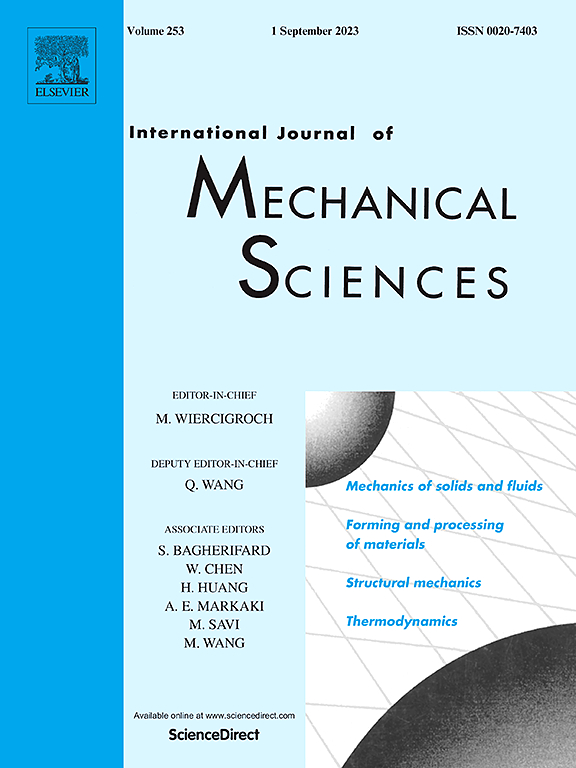Composition and layered co-continuous structure co-regulate shape memory properties
IF 7.1
1区 工程技术
Q1 ENGINEERING, MECHANICAL
International Journal of Mechanical Sciences
Pub Date : 2025-03-24
DOI:10.1016/j.ijmecsci.2025.110187
引用次数: 0
Abstract
4D printed shape memory implant is highly promising for the realization of minimally invasive, while challenged by the poor shape memory effect (SME) of commonly used biodegradable shape memory polymer (SMP) such as poly(L-lactic acid) (PLLA) and thermoplastic polyurethane (TPU). Herein, the shape memory bone scaffold was fabricated by laser powder bed fusion (LPBF) with layered co-continuous structures containing PLLA and TPU. And SME of the scaffold was ameliorated by regulating the material composition and constructing a special layered co-continuous structure for the first time. The layered co-continuous structure could avoid the impact of morphology on SME due to the immiscibility between PLLA and TPU, thus broadening the window of tuning the SME. As the ratio of PLLA and TPU decreased gradually, the shape fixity ratio (Rf) decreased and the shape recovery ratio (Rr) increased. This was attributed to the combination of changes in the ratio of "switching segment and netpoint" and the reverse stiffness effect between PLLA and TPU. Besides, due to the efficient stress transfer in the layered co-continuous structure, the Rf and Rr would be considerably changed only when the content threshold of the switching segment or netpoint was reached. A good SME was obtained when the ratio of TPU to PLLA was 2:1, with Rf of 96.5 % and Rr of 96.71 % compared to the pure PLLA. Additionally, the scaffold exhibited sufficient compressive strength and benign cytocompatibility. This study proposed a new and simple but effective strategy to prepare bone scaffold with excellent shape memory properties.

组成和层状共连续结构共同调节形状记忆性能
4D打印形状记忆植入物在实现微创方面具有很大的前景,但目前常用的可生物降解形状记忆聚合物(SMP)如聚l -乳酸(PLLA)和热塑性聚氨酯(TPU)的形状记忆效果较差,这一问题受到了挑战。本研究采用激光粉末床融合技术(LPBF)制备了含有PLLA和TPU的层状共连续结构的形状记忆骨支架。并首次通过调节材料组成,构建特殊的层状共连续结构来改善支架的SME。层状共连续结构可以避免由于PLLA与TPU之间的不混溶而导致的形貌对SME的影响,从而拓宽了SME的调谐窗口。随着PLLA与TPU的比例逐渐降低,形状固定比(Rf)减小,形状恢复比(Rr)增大。这是由于“开关段和网点”比例的变化以及PLLA和TPU之间的反向刚度效应共同作用的结果。此外,由于层状共连续结构中有效的应力传递,只有达到开关段或网点的含量阈值时,Rf和Rr才会发生较大的变化。当TPU与PLLA的比例为2:1时,与纯PLLA相比,Rf为96.5%,Rr为96.71%。此外,支架具有足够的抗压强度和良好的细胞相容性。本研究提出了一种简单有效的制备具有优异形状记忆性能骨支架的新方法。
本文章由计算机程序翻译,如有差异,请以英文原文为准。
求助全文
约1分钟内获得全文
求助全文
来源期刊

International Journal of Mechanical Sciences
工程技术-工程:机械
CiteScore
12.80
自引率
17.80%
发文量
769
审稿时长
19 days
期刊介绍:
The International Journal of Mechanical Sciences (IJMS) serves as a global platform for the publication and dissemination of original research that contributes to a deeper scientific understanding of the fundamental disciplines within mechanical, civil, and material engineering.
The primary focus of IJMS is to showcase innovative and ground-breaking work that utilizes analytical and computational modeling techniques, such as Finite Element Method (FEM), Boundary Element Method (BEM), and mesh-free methods, among others. These modeling methods are applied to diverse fields including rigid-body mechanics (e.g., dynamics, vibration, stability), structural mechanics, metal forming, advanced materials (e.g., metals, composites, cellular, smart) behavior and applications, impact mechanics, strain localization, and other nonlinear effects (e.g., large deflections, plasticity, fracture).
Additionally, IJMS covers the realms of fluid mechanics (both external and internal flows), tribology, thermodynamics, and materials processing. These subjects collectively form the core of the journal's content.
In summary, IJMS provides a prestigious platform for researchers to present their original contributions, shedding light on analytical and computational modeling methods in various areas of mechanical engineering, as well as exploring the behavior and application of advanced materials, fluid mechanics, thermodynamics, and materials processing.
 求助内容:
求助内容: 应助结果提醒方式:
应助结果提醒方式:


